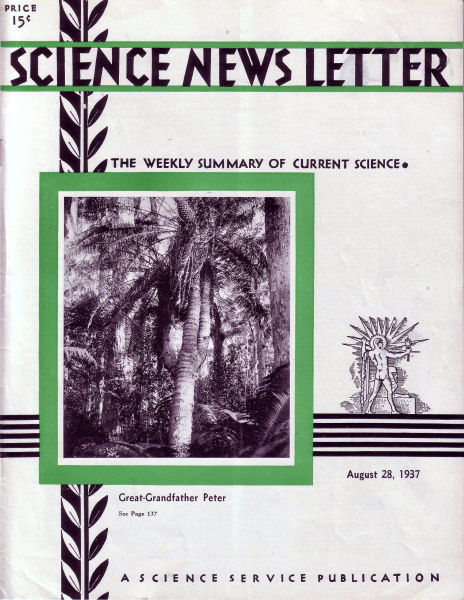From the August 28, 1937, issue

FORESTERS STRIVE TO SAVE NOTABLE GIANT CYCAD TREE
Can Australian foresters save Great-Grandfather Peter?
Thoughtless boys cut him down. The foresters have set him up again, and hope he will keep on living.
Great-Grandfather Peter is the local name given to a big cycad, perhaps the oldest tree of its kind in the world. It grew on Tambourine Mountain, near Brisbane, Australia, until a short time ago when a group of boys, idly looking about for something to chop at, cut it down.
At the time, word went out that the fallen giant was 10 or 15 thousand years old. This, however, has more local patriotism than solid science behind it, for there is no way of estimating the age of this particular kind of tree. Rings in a cycad (when they are there at all) are not formed in the same way as rings in other trees, and so do not have the same meaning.
The fall of Great-Grandfather Peter was looked upon as a real calamity. The tree had long been a familiar landmark in the Tambourine Mountain woods, and was thought of as an individual. People who knew boasted of the great tree’s 3-foot-long cones, weighing upwards of 85 pounds, as though they were the exceptional children of a human neighbor.
The forester treated the cut surface of the tree with an antiseptic solution and set it upright in a hole in the earth, hoping that it would strike root and live again. This has happened in the case of smaller specimens of cycads, though of different kind from Great-Grandfather Peter. There is enough stored food in the thick trunk, dense and heavy as stone, to keep the plant alive for several years even without roots. So the old tree’s human neighbors wait and hope.
Cycads are found now only in tropical and subtropical lands. Most of them look rather like palms, and are often so called. But botanically, despite appearances, they are more nearly related to pines than to palms.
The photograph of Great-Grandfather Peter reproduced on the front cover of this issue of The Science News Letter was taken by Mrs. Hilda Geissman Curtis, who lives on Tambourine Mountain.
STRANGE LIGHT EMITTED BY OVER-SPEED ELECTRONS
A strange glowing light can be caused by swift-moving electrons shot into a pure liquid. This light can only be accounted for if it is assumed that the moving atomic “bullets” are traveling faster than could light rays in the same medium.
This strange happening, which might seem at first glance to controvert Einstein’s theory of relativity but does not, is reported by the Russian scientist P.A. Cerenkov (The Physical Review Aug. 15).
In a rough way, the new phenomena are similar to the creation of sound waves by a bullet. Almost everyone knows that the “zip” of a bullet comes along after the bullet has passed; that is, the speed of the bullet is greater than the speed of the sound waves that it creates.
In the Russian experiments just reported, the “zip” of the electron bullets is not sound but light; very faint but real.
The atomic electron bullets used in the experiments were obtained either from disintegrating radium as the so-called beta rays, or as the Compton recoil electrons created when gamma radiation impacted the pure liquids under study. Both kinds of electron bullets produced the light.
Queerest characteristic of the new kind of light is its distribution in space. It does not come out, from the liquid being studied, equally in all directions. Rather it tends to issue forward along the line in which the electrons are traveling. In the photographic records obtained of the light, it appears as something like a headlight beam coming out from the swift-moving, but invisible, electron beam.
A basic postulate of Einstein’s theory of relativity is that in a vacuum the speed of light would be constant and the “fastest” thing in the universe. In liquids and other mediums of light propagation, however, the speed of light, as is well known, is less than the ideal postulate of Einstein. Thus it is strange, but not necessarily unreasonable, that the only explanation of the newfound light that completely explains the phenomenon consists of assuming that the electrons race through the pure liquids faster than could light rays.
NEW VITAMIN B FACTOR DISCOVERED AT WISCONSIN
A new factor which belongs to the vitamin B complex, and which is needed for the nutrition of animals was recently discovered by C.A. Elvehjem, C.J. Koehn, and J.J. Oleson, University of Wisconsin scientists working in cooperation with the Wisconsin Alumni Research Foundation.
With the existence of the new factor established, the scientists turned their attention toward isolating it. Certain discarded fractions of the liver that have been used in preparing vitamin B2 and flavin were precipitated with a mixture of alcohol and ether, and when tested were found to be highly active in the new factor. Further purification and concentration have been brought about by means of solvents and precipitation.
The work done thus far has made it possible to describe the behavior of this factor when subjected to various treatments. It is readily soluble in water, but not in acetone. It is absorbed on charcoal at neutral pH. It is readily destroyed by heat in autoclaving.
Thus far, no extensive study has been made on the distribution of this factor, but it has been found in considerable quantities in yeast and fresh milk. Cereal grains seem to be very deficient in it.
Since this factor may have considerable importance in animal nutrition, the Wisconsin research workers will follow up their discovery with an intensive investigation of the role it plays.






